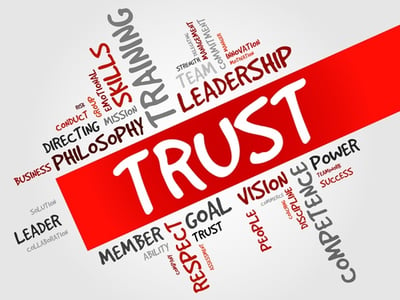Inbound Smarketing is a Competitive Advantage
Making the change from sales to consulting in a smarketing (sales + marketing, explained more here) way is a strategic initiative. According to the Economist Intelligence Unit’s Why Good Strategies Fail: Lessons for the C-Suite, “88% of respondents say that executing strategic initiatives successfully will be ‘essential’ or ‘very important’ for their organizations’ competitiveness over the next three years” (p. 5).
Inbound smarketing is a competitive advantage, when it’s done well.
But with statistics telling you that 70% of change initiatives fail (thanks, Harvard Business Review) and only 25% of change initiatives are successful long-term, it would be easy to ignore potential benefits in favor of the status quo. After all, you’re making some sales, and your ROI is somewhat positive.
C'mon, guys - that’s what you want your business legacy to look like? Let’s consider these statistics instead:
- Companies with aligned sales and marketing generated 208% more revenue from marketing. (MarketingProfs)
- When sales and marketing teams are in sync, companies became 67% better at closing deals. (Marketo)
- Alignment of sales and revenue impacts revenue growth up to 3 times. (Bulldog Solutions)
Now that's more like it. I’m here to give you some practical advice for successfully implementing strategic change at your organization, based on my own experience in change leadership.
Background
I was brought in as CEO and a change management leader to a construction company. The company was medium-sized but wasn’t performing optimally for future growth. We were facing the following issues:
- No alignment between sales and marketing to meet goals
- No measurement to determine qualified vs. unqualified leads
- Limited educational material for both sales and marketing to use to engage prospects and leads
- Bad habits ingrained amongst the sales team leaders for sales process
 The first big issue was tension between the sales and marketing teams. As is typical in many companies, the two departments were siloed and had no communication. Too often, marketing materials are built to attract but rarely address the actual challenges and feedback sales is getting from prospects, which is a pillar of inbound marketing. Building marketing materials based on sales goals to meet prospects’ needs is key, and will align the two teams’ goals. But that’s just the first step, and the easier one at that.
The first big issue was tension between the sales and marketing teams. As is typical in many companies, the two departments were siloed and had no communication. Too often, marketing materials are built to attract but rarely address the actual challenges and feedback sales is getting from prospects, which is a pillar of inbound marketing. Building marketing materials based on sales goals to meet prospects’ needs is key, and will align the two teams’ goals. But that’s just the first step, and the easier one at that.
The second major issue was the lack of a defined sales process. People were just doing what they wanted to do. This was causing a number of problems:
- Leads were falling through the cracks. They weren’t even cracks; it was more like moveable wooden planks on an old bridge.
- No one was following the same procedures - so potential clients would hear multiple different scenarios, prices, or solutions from different salespeople.
- Sales were stagnant, and there was high turnover and low morale on the team.
Change Starts With Building Trust
 My first week there, I did a lot of listening, and a lot of shadowing. Many change managers believe that to make an immediate impact, you need to come in, first day, with a new process and change everything up and then enforce it - but that’s not going to work. You’re working together with people and their livelihood; you need to respect their experience, pain points and ideas.
My first week there, I did a lot of listening, and a lot of shadowing. Many change managers believe that to make an immediate impact, you need to come in, first day, with a new process and change everything up and then enforce it - but that’s not going to work. You’re working together with people and their livelihood; you need to respect their experience, pain points and ideas.
Before implementing anything, go and ask lots of questions of the whole team. This builds up your credibility. You could be doing all the things they want, but they’re not going to trust the person who doesn’t talk to them first.
Always ask the individuals a set of questions:
- What do you think works and doesn’t work?
- In a perfect world, how would you do it?
- If you were the CEO, what process would you put in place?
By asking these simple questions, people don’t feel like they’re being criticized; instead, they feel like they’re outside their current role and imagining a better world, and it works better. Their answers give an idea of what they already know is broken, and what potential ideas they have to fix them.
Identify the Working Parts
 The construction company had one really great residential and one excellent commercial salesperson. I shadowed each person for a week. Then, I followed up and documented the steps they were doing. When asked, they each said, “I don’t really have a process - I just wing it.” But that wasn’t actually the case - they had habits and steps they took every time, and I identified those to make them repeatable for the whole team.
The construction company had one really great residential and one excellent commercial salesperson. I shadowed each person for a week. Then, I followed up and documented the steps they were doing. When asked, they each said, “I don’t really have a process - I just wing it.” But that wasn’t actually the case - they had habits and steps they took every time, and I identified those to make them repeatable for the whole team.
I implemented the process of those excellent salespeople for the whole team. Until we did that, there had been a revolving door.
Enforce the Change
When I first arrived and took stock of the situation, I had a clear goal in mind: increase our sales and ROI. My process for change management was simplistic, but definitely not easy to do. It required patience and consistency over a long time.
- Start by listening. Listen to the good salespeople and the bad. Listen to their reasoning, their suggestions, their struggles.
- Communicate the overall goals very clearly - why we’re doing this, what’s in it for them, what’s in it for their clients, and how we all benefit.
- Introduce a new step, goal, change every couple of weeks. Really broadcast the quick wins when people followed the new process and the wins were done right. In my case, I took over training myself to keep newer people from learning bad habits, and that’s when the real change was made.
- Be consistent. Be so consistent that you even bore yourself. Keep saying the things over, and over, and over. You’ll feel like it’s not working. But that consistency will pay off.
- Be prepared to change incentives and even hiring practices to enforce the change. That might mean changing pay rates, bonuses, or other incentives. Everything must be aligned.

Change management is difficult for a reason, and many leaders will leave when the enforcement of a new process gets frustrating. People with bad habits have seen leaders of change come and go, without ever being forced to change their habits; I, too, was working against this at the construction company. That made communication and consistency even more important. When it comes to smarketing, changing a team from being sales-focused to consultant-focused changes the reason why they’re there. Hire the right people based on your goals moving forward.
When introducing, enacting and enforcing the concepts of inbound smarketing to your team, these practical tips will come in handy. If you’re looking to strategically implement this strategy in your organization, I’d love to assist with both inbound and sales enablement. Reach out to me today.




